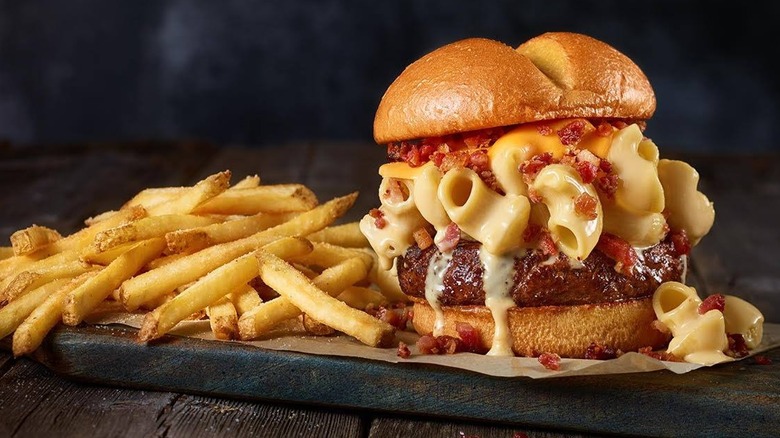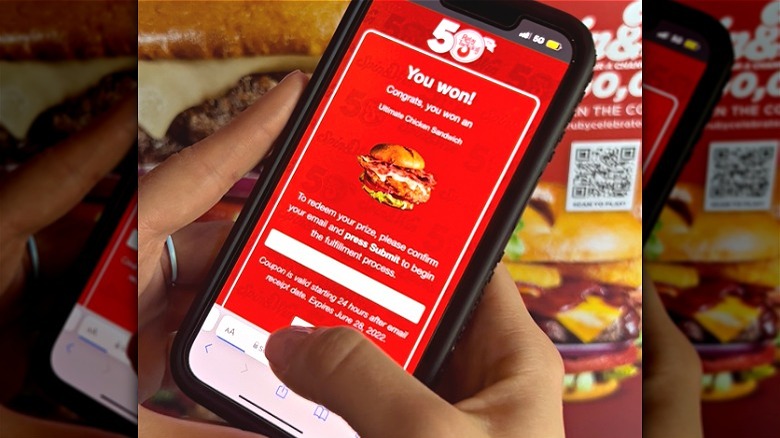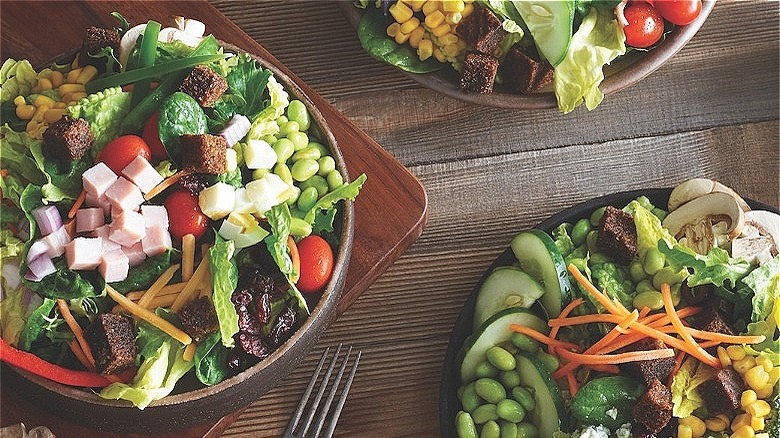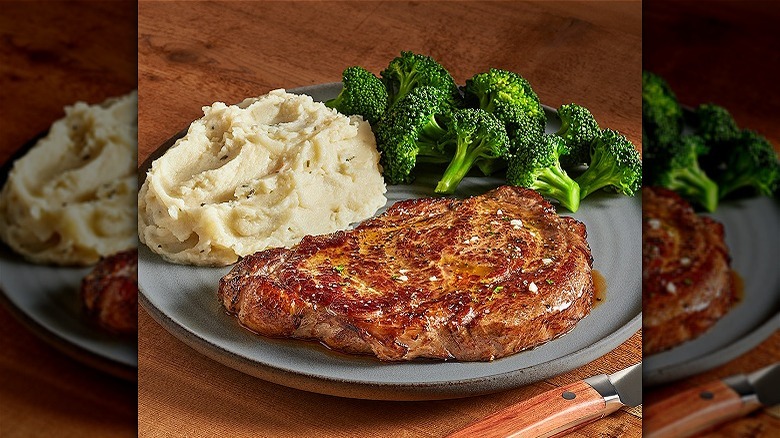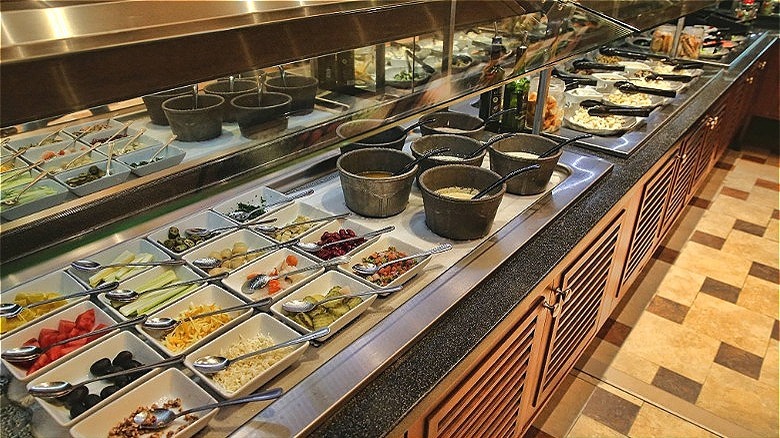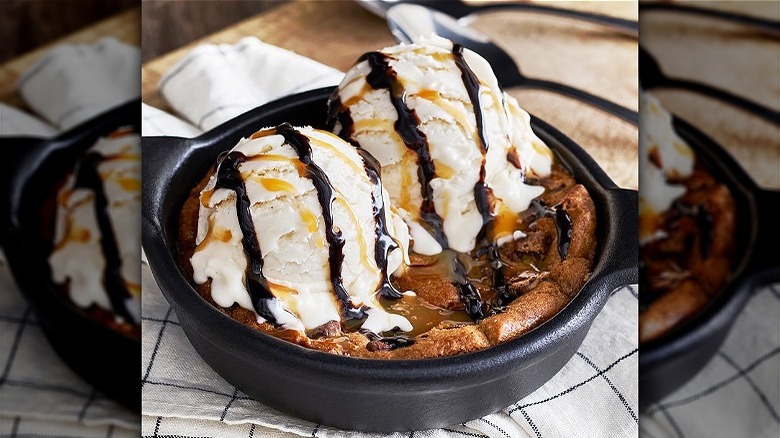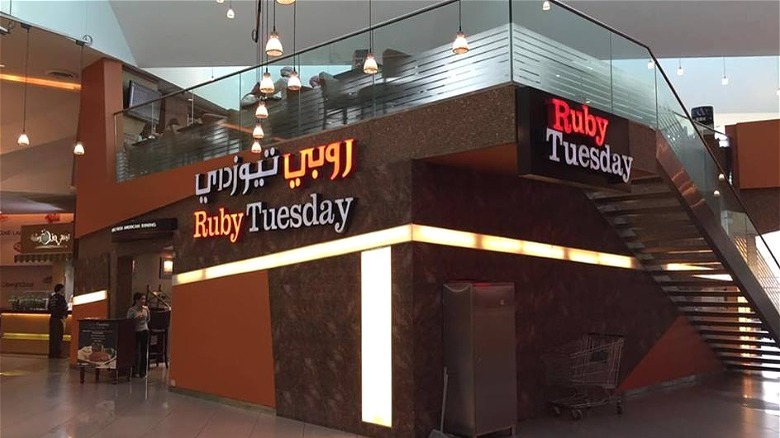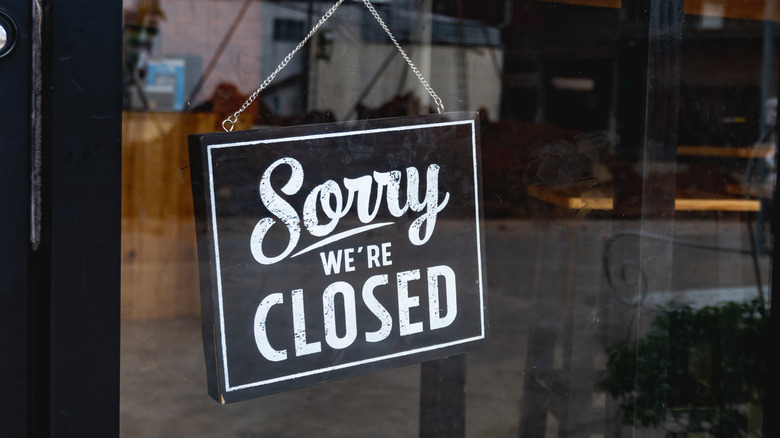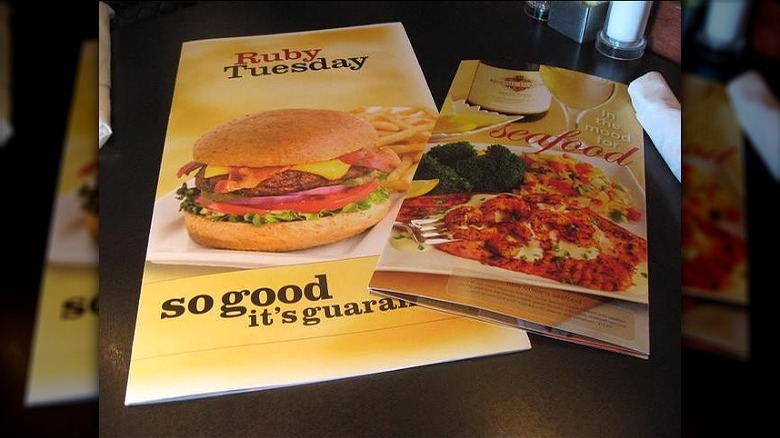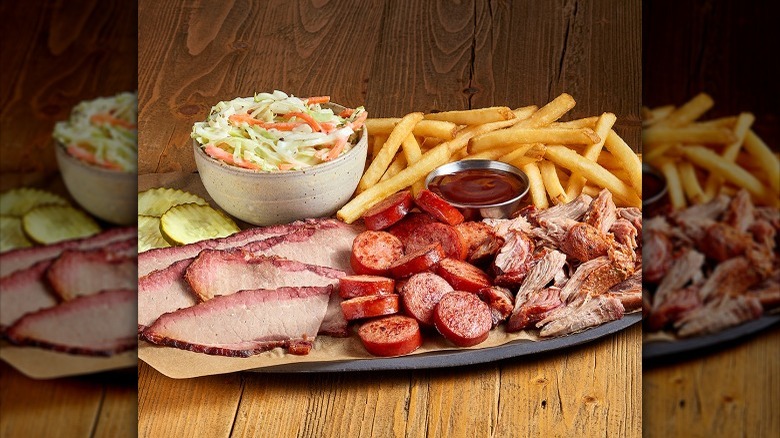We Finally Know Why Ruby Tuesday Is So Cheap
"Simple Fresh American Dining." Those four words embody the core values behind Ruby Tuesday, the Tennessee establishment Samuel E. "Sandy" Beall and his friends kickstarted in 1972 (per Funding Universe). Famous for its salad bar and laidback chophouse grub, the sit-down spot once dominated malls and suburbs alike at the height of the '80s buffet frenzy, an era that seems sadly behind us. Due to shifting dining trends and financial strife caused by the COVID-19 pandemic, Ruby Tuesday's footprint has been torpedoed to just over 200 company-owned restaurants (via Reuters).
Although its future seems unclear, one thing's for certain and that's this: Ruby Tuesday has been, and always will be, a budget-friendly destination. Funding Universe writes that Beall's intended price point for customers was no more than $10, which means most of its entrees — including pasta, seafood, and steak cutlets — won't ring up a huge bill. How is this possible? For starters, the restaurant has employed a host of strategies throughout its 50-year run guaranteeing that customers never pay more than they have to for a satisfying meal. These tactics, from slimming down the menu to remodeling the salad station, have helped the chain meet its target and stay on top of the bargain-hunting game. But those moves are just the tip of the iceberg as to how Ruby Tuesday can get by on next to nothing. Read on to find out why Ruby Tuesday is so cheap.
Ruby Tuesday regularly offers discounts
Walk into Ruby Tuesday any day of the week, and you'll happily land upon a barrage of tasty deals – $2 beers, sirloin steaks for $10.99. Heck, even little ones can eat free on Fridays. Offering promotions, and offering them regularly, is what keeps Ruby Tuesday's menu so affordable to the average diner. And as it happens, regular visitors can transform their loyalty into freebies by signing up for Ruby Tuesday's membership program, SoConnected, on its website.
One example of just how low Ruby Tuesday's prices can go came in February 2022, when it debuted new menu items. To coincide with the launch, as well as National Margarita Day, Ruby Tuesday decided to offer specials starting at just $2 (via FSR Magazine). You heard that right — mini-sized margaritas, draft brews, and other edibles could be acquired with essentially pocket change. And of course, the deal fell on a Tuesday (or "2's Day").
Lunch specials starting at $6 and unlimited trips to the salad bar are tantalizing offers, and thereby a surefire way to get butts into seats. The more visitors who come back, the higher the profit margin for Ruby Tuesday, and thus the more incentive there is to continue the cycle of constant discounts that have worked in its favor. It's a self-fulfilling prophecy. Such irresistible savings all but guarantee two things — that there'll be an increase in foot traffic, and thereby more customers present to take advantage of the deals.
The produce isn't organic
Getting your veggie intake is easy-peasy thanks to Ruby Tuesday's salad bar. But if you wish to nourish yourself with clean greens, then the sit-down chain is going to disappoint. While Ruby Tuesday supplies its Garden Bar with farm fresh produce, none of it can be considered organic. The franchise doesn't hide this fact; if anything, it's been more than transparent. Former CEO J.J. Buettgen remarked in 2015, "We are pretty focused on food quality [but] not necessarily, at this point, on local/organic" (via Food Business News).
Although a study by the USDA Economic Research Service suggests that the price premium on organic products has mellowed out in recent years, it still costs a lot out of pocket. According to the USDA, vegetables that are organic can't be grown or manufactured using synthetics or procedures that cause ecological harm. The process is more specialized and requires more work to fulfill the demand, and the bounty accumulated at the end is far smaller than the industry norm, thus resulting in an increased sticker price (per The Food and Agriculture Organization of the United Nations).
The former CEO didn't rule out the possibility of Ruby Tuesday ever going green. Rather, he noted that the chain would keep the potential in mind and wait to see if the trend would stick around. Since organic food doesn't appear to be going anywhere, we can safely assume Ruby Tuesday has chosen to prioritize frugality over procuring spinach grown without GMOs.
Side dishes are made with cheap ingredients
Unlike a buttery Ribeye or roasted chicken breast, the side dishes are where Ruby Tuesday saves money. Much of its menu can stay relatively affordable because the sides are just plain cheap. Just looking at Ruby Tuesday's menu online, you'll notice that none of them require extravagant seasonings or complicated cooking techniques, and the ingredients themselves are frugal to obtain. For example, zucchini costs $1.20 by the pound on average, according to the U.S. Department of Agriculture (via The Packer). Rice for the chain's rice pilaf side is a whopping 82 cents per pound (via Statista). And it's convenient that mashed spuds compliment a steak dinner so swimmingly, because potatoes are also easy to buy in bulk, averaging at 78 cents a pound (via Statista).
If you remain skeptical of the economical properties found in a Ruby Tuesday accompaniment, heed the words of this anonymous employee who once provided Daily Press with the recipe for its potato salad. Essentially, the ingredients consisted of cheap kitchen staples: russet potatoes, green pepper, bacon, and chopped onion. Same thing for the dressing, which allegedly mixes humble components including celery salt, mustard, pepper, and classic mayo.
By maintaining a low-maintenance approach to the garnishes, Ruby Tuesday can focus its dollars on the entrees that compose the main attraction of any sit-down meal. The meat, so to speak, is what people come for, so keeping the side dishes affordable allows for excess in other places.
Ruby Tuesday prioritizes its salad bar
What draws customers to dine at a Ruby Tuesday over similarly priced establishments? The salad bar. It's the reason why 80% of its clientele visit the restaurant in the first place (via Nation's Restaurant News). Aiming to turn its slumping sales around in 2017, the chain decided to give its signature offering a refresh with dozens of fresh new fruits and veggies, creative toppings, cheese, and dressings — nearly doubling the size of its show-stopping salad bar.
The new and improved Garden Bar sought to attract a younger crowd by modernizing the build-your-own concept to reflect current tastes (per The Florida Times-Union). In addition to featuring a higher number of toppings (nearly 60!), the upgraded salad bar showcased artisanal ingredients and dressings made from scratch daily (via Clark.com).
On the surface, the decision to refine the salad bar is pretty simple. Ruby Tuesday decided to make changes to what the brand is already known for — that is, the customizable salad bar – as opposed to the riskier alternative of hopping aboard a new trend the restaurant has no prior experience dealing with. Additionally, it's a smart investment in terms of its competitive value. Commenting on the Garden Bar's unveiling to Nation's Restaurant News, then-interim CEO Lane Cardwell described the Garden Bar as "not something that can be easily replicated" at other eateries. High quality, plus a dash of novelty, equals unparalleled satisfaction.
And leans on drinks and desserts to push profits
While the salad bar is Ruby Tuesday's moneymaker, there's two categories the restaurant leans on to increase sales: drinks and desserts. Former CEO J.J. Buettgen commented on the efforts taken to expand the restaurant's selection back in 2015, saying "If you were to look at our brand versus some of our competitors, whether that's casual dining at large or a bar and grill, we under-index some of the others in both alcoholic beverages and desserts, so we're strengthening those offerings" (via Food Business News).
According to Ruby Tuesday's website, happy hour discounts are offered daily along with $5 cocktail specials, seasonal selections, and cheap upgrades for a bigger beverage. The bar serves major beer brands, both domestic and imported, and also caters to health-conscious diners with low-calorie version of popular cocktails (via Bar & Restaurant). As for dessert, the main menu features standard fare like ice cream sundaes and cookie skillets, yet it also embraces seasonal flavors from time to time — pumpkin cheesecake makes a regular appearance during the fall months (via Twitter).
As guaranteed crowd-pleasers, the lure of baked goods and booze will ensure Ruby Tuesday makes a killing night after night. And unlike some of the main entrees, they're easier to serve in large quantities. Since many patrons are already in the mood to cap off their gorge fest with a pint of Guinness or chocolate lava cake, Ruby Tuesday might as well give them what they want.
Real estate is shared with other restaurants
The next time you hit up Ruby Tuesday for dinner, take note of your surroundings. Chances are high that you are feasting at a mall location. Operating in shared lots was a strategy Ruby Tuesday implemented in the 1990s, Funding Universe notes, to offset the real estate costs that come with standalone facilities. And this remains true even in the face of fewer locations standing today. Mall Seeker lists over a dozen active restaurants at shopping plazas in New Jersey, Florida, Georgia, and more.
The rationale of gathering a variety of eateries within close range is fairly straightforward — less money will be spent. Because financial upkeep of the complex is split between multiple franchises, the cost of running a restaurant (kitchen equipment, heating, utilities, etc.) can be slightly lowered just by sharing the bill. Restaurant Owner reports that the average brick-and-mortar eatery spends $5,000 a month on rent alone, so every penny does count.
Fear of competition could sway some restaurants from going the communal route. But the upside of sharing space with other businesses? It levels the playing field. Customers benefit by having more dining options to choose from, and the restaurants who participate benefit from not having to spend as much money on necessary, although costly, expenditures. It's a win-win for everyone involved, and nothing wins more than a Ruby Tuesday customer's wallet.
Poorly-performing locations close down
Just a few years ago, Ruby Tuesday had over 700 restaurants to its name (via BizJournals). As of 2021, however, that number's been whittled down to a couple hundred, according to Restaurant Business. Shutting down under-performing locations has been paramount for Ruby Tuesday's bottom line, since operating any restaurant, let alone one that fails to generate high profits margins, is more expensive in the long run.
There have been multiple instances where Ruby Tuesday has been forced to scrap stores, and in each case it was out of financial necessity. In 2014, Nation's Restaurant News reported that stagnant sums led to the chain cutting 24 restaurants. In 2016, an additional 95 were shuttered in order to combat the $27 million loss felt from the previous quarter (via CBS News). And in 2020, when the chain announced plans to declare Chapter 11 bankruptcy, guess what the franchise had to do? That's right, close down more locations — precisely 185 went out of business in response to the franchise's financial restructuring agreement (per USA Today).
Compared to offsite service methods like takeout or delivery, the bulk of Ruby Tuesday's business happens at a physical restaurant (90%, according to USA Today). That means the establishments in question need to be profitable. And if they aren't, for any reason, the financial hit will certainly take a toll on the budget. Should Ruby Tuesday's budget-friendly reign continue, it will be necessary to trim the fat, so to speak.
Tipped employees don't make much money
Working in the service industry can be a rewarding experience for many. But anybody who's been hired by a bustling chain restaurant knows how underwhelming the paycheck can be. Low wages seem to be a frequent explanation lurking behind any restaurant discount — because it usually is. And Ruby Tuesday is far from an outlier in compensating its workers with the bare minimum. Zippia found that a typical employee will only make $13.20 an hour, with workers at the bottom taking home around $17,000 annually, if that.
It's true that Ruby Tuesday employees across the board aren't paid much, but no one gets the shaft quite like tipped workers. A former Ruby Tuesday bartender explained on Reddit how workers who subsisted off of gratuities had to participate in tip pooling — a practice where tips are summarily split between workers during a whole shift as opposed to each worker pocketing all of their own tips (via Upserve). Breaking down the hours worked and tips accumulated, they found that a shift could result in less $2 per hour in tips. As they explained, "The company charges more than $2 for something as simple as a flavored iced tea, and although I may make dozens of drinks in an hour, I am not even being paid the cost of one of those drinks."
A smaller menu saves Ruby Tuesday time and money
While everyone was busy fawning over the tricked-out Garden Bar, Ruby Tuesday did away with 30% of its menu. As The Florida Times-Union reports, reducing the number of entrees was much more than a simple cost-cutting maneuver. The decision was made to help the restaurant chug along faster in serving customers, which also carries the advantage of reducing messed up orders, and altogether improves the chances that happy diners will come back.
Ruby Tuesday has always thrived off variety, but in its defense, serving a wide array of choices doesn't necessarily mean that customers will feel compelled to order them. Cooks are expected to prepare a variety of meals, with waitstaff shouldering the labor of serving those dishes to customers in a prompt manner. A barrage of different entrees can drastically slow down the pace of a high-traffic eatery, particularly during peak hours, so having fewer options makes the job much easier for the workers involved. Not to mention the food will be much fresher and less at risk of going to waste.
Although it's tempting to believe phone book-sized menus will inspire enthusiasm among diners, it's not feasible for Ruby Tuesday if it wants to keep its budget in order. Trimming down the menu, whether out of pragmatism or to adapt to changing trends, is the only way diners can enjoy bargain prices.
Virtual brands operate under the Ruby Tuesday name
Ruby Tuesday unveiled a spinoff concept in 2021 called Libby's BBQ, whose smoked meats and picnic sides would be right at home under the chain's regular menu. The kicker? Libby's BBQ has no standalone locations — it's only available at Ruby Tuesday (via Business Wire). Virtual brands have been a big focus for Ruby Tuesday following its financial struggles, and for good reason, too (per Restaurant Dive). How so? They're cost effective.
To create a virtual brand requires no additional investments in a physical space. So long as there's a kitchen, equipment, and workers to assemble orders, the need for a storefront is basically moot. Ruby Tuesday already has the real estate at its disposal, plus over 32,000 employees in its orb to make items off both the Libby's BBQ and Ruby Tuesday lineup (per Zippia). Additionally, menus tend to be more limited in scope than full-scale eateries, as QSR Magazine reveals, which means fewer ingredients (and workers) are called for to prepare them. And at the end of the day, virtual concepts mean more offerings for customers, which only serves to drive profits if done right.
General managers are extensively trained and it pays off
If anything can alleviate staffing woes, it's good training. A 2020 report by the Work Institute showed that employees were more likely to quit due to inefficient coaching over any other issue. But Ruby Tuesday stands out for providing its employees, particularly management, with proper instruction. Per Workforce.com, training seminars are held at the company's headquarters in Maryville, Tennessee, which go far beyond the motivational filler found in most corporate setting. Plus, managers have to pass every test with flying colors — otherwise they don't move up.
As part of the chain's itinerary, management undergoes rigorous schooling for the purpose of educating the employees that they oversee in their role. In some cases it's interactive, such as learning how to mix alcoholic beverages on the menu and to concoct new ones (via Bar & Restaurant). But Ruby Tuesday also relies on "prescriptive training," a time-saving measure that meets employees at their current wavelength as opposed to giving complete overviews on a topic of interest (via Workforce.com). Even outside corporate headquarters, the learning never stops, as extensive resources are given to employees across all sectors.
According to former director of training and development Jim Domanic, customers were much happier with Ruby Tuesday following the implementation of these tactics (via Workforce.com). Not only are highly-skilled staff a valuable part of the dining experience, but they cut down on the cost of future hires, since happier employees will likely stick around the company longer.
Marketing on social media is an effective tool
Thanks to the internet, Ruby Tuesday doesn't have to rely only on cable for its marketing strategy. Marketing Dive reports that during a notable slump in 2015 the franchise started promoting its brand on Facebook, Twitter, and Instagram to reach out to its customer base. And it was, in fact, a success. According to Chief Marketing Officer Dave Skena, establishing an online presence made advertising much easier because of the direct, yet accessible nature of social media (via Digiday).
What exactly inspired Ruby Tuesday's shift towards social media marketing? Certainly, it would be foolish for companies not to take advantage of the medium as smart phones practically run our lives. But for Ruby Tuesday, it wasn't just to keep up with the Joneses. Digiday reports that its top demographic — young mothers with kids — were opting for the social media over more traditional forms, such as TV, to consume content. Besides that, utilizing social media sites made more sense for the brand's size, as unlike McDonald's and Starbucks, Ruby Tuesday's appeal is regionally-grounded, specifically on the East Coast.
A well-timed tweet or Facebook graphic can spread faster and with more efficiency than, say, a TV commercial. And compared to making commercials, a social media post is downright minimal. At the end of the day, more people will find out about Ruby Tuesday's jaw-dropping discounts and it will have cost barely anything to accomplish. It's something Ruby Tuesday does well.
